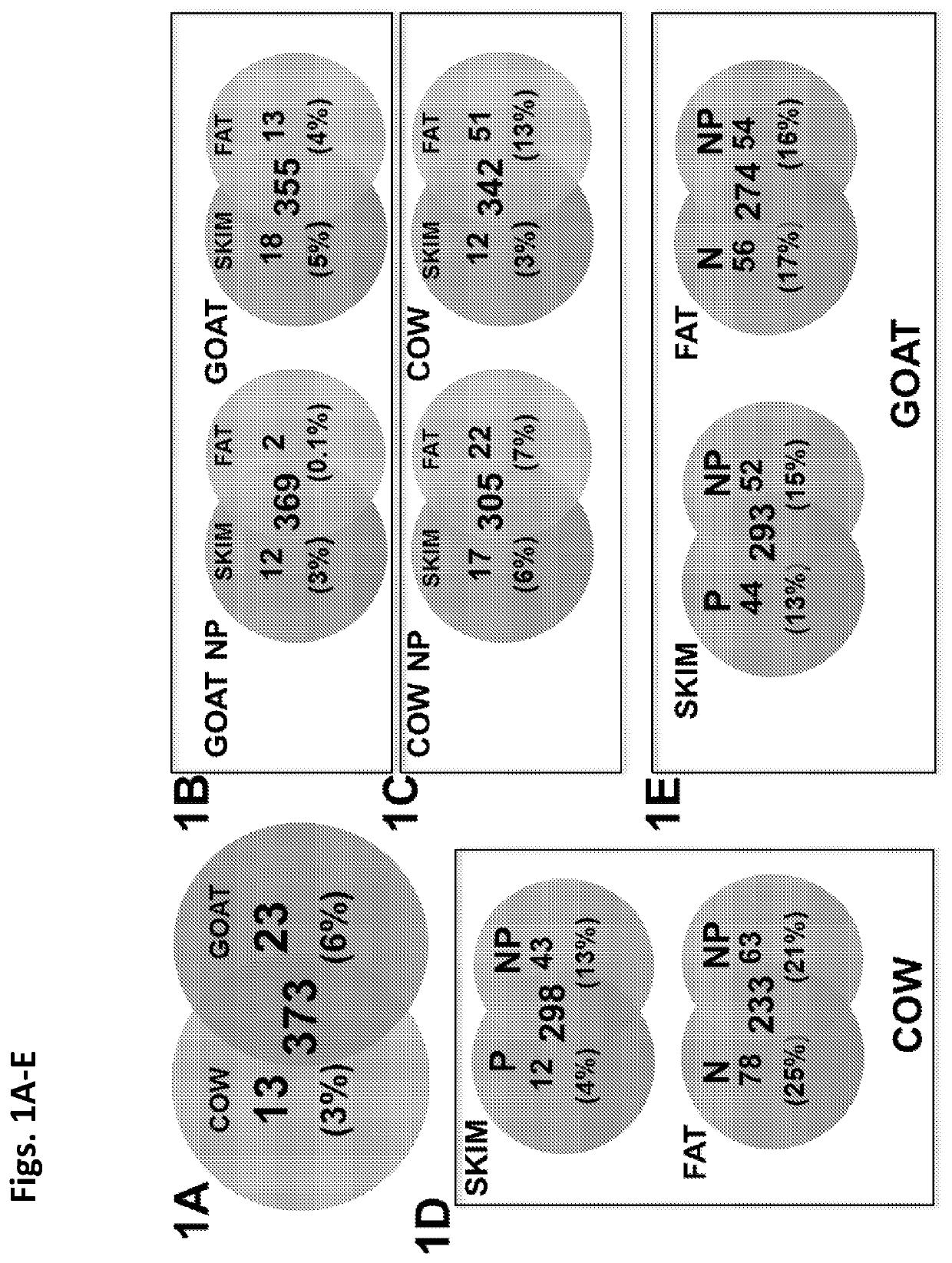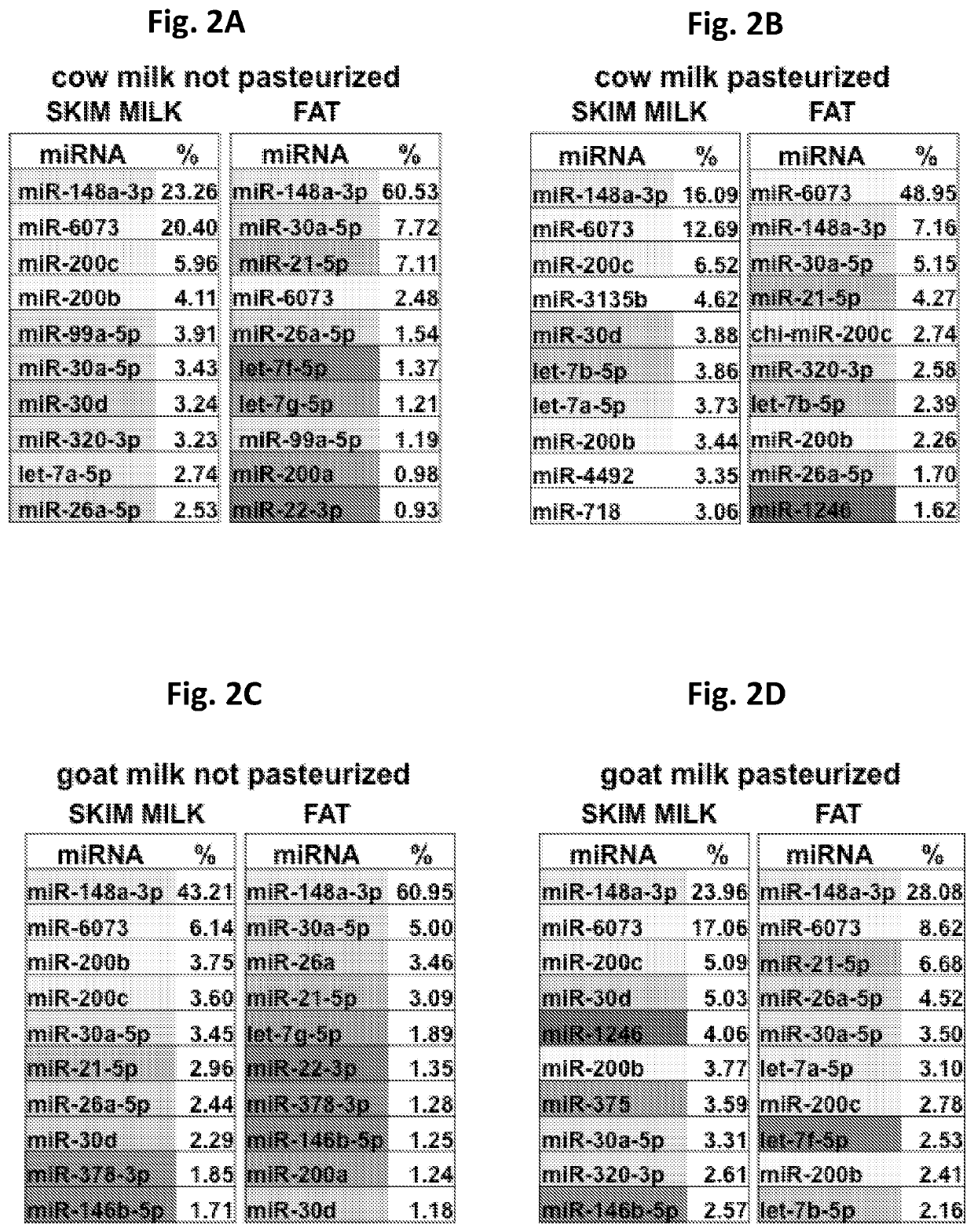Supplementation of milk formulas with microvesicles isolated from milk
a technology of microvesicles and milk formula, which is applied in the field of microvesicles, can solve the problems of lack of many components and infant formulas that are not identical to natural milk, and achieve the effects of low skim fraction, high conservation, and beneficial mirna expression
- Summary
- Abstract
- Description
- Claims
- Application Information
AI Technical Summary
Benefits of technology
Problems solved by technology
Method used
Image
Examples
example 1
Expression Profile of miRNA in Human Breast Milk, Bovine and Goat Milk
[0086]Analysis of the profile expression of miRNA in human breast milk, bovine and goat milk was performed by next generation sequencing (NGS): Milk samples were collected from human female mothers from pre-term and term babies at different time points after delivery. Preterm mothers were mothers to babies born at weeks 28-36 of pregnancy. Term mothers were mothers to babies born at weeks 37-42 to pregnancy. Milk samples were collected on 2 days postpartum-colostrum, 1 month postpartum, 3 month postpartum, 6 month postpartum and 9 months postpartum. Likewise, milk samples and from cow and goat milk were collected before and after pasteurization. Fat and skim fractions of the milk were separated by several centrifugations. Milk is fractionated by centrifugation at 5000 g for 30 minutes at 4° C. Three fractions are obtained from the milk: lipids, skim milk and cells.
[0087]NGS was used to analyze the profile of miRNA...
example 2
Validation of the Next Generation Sequencing (NGS) Results by RealTime PCR (qRT-PCR).
[0093]A. Expression of miRNA-148a-3p in breast milk—Milk samples were collected from human mothers from pre-term and term babies at different times of lactation. Preterm mothers were mothers to babies born at weeks 28-36 of pregnancy. Term mothers were mothers to babies born at weeks 37-42 to pregnancy. Milk samples were collected on 2 days postpartum-colostrum, 1 month postpartum, 3 month postpartum, 6 month postpartum and 9 months postpartum.
NGS analysis revealed that miRNA-148a-3p (mir-148a) is one of the predominantly expressed miRNAs in the skim and fat fraction of the breast milk from mothers of pre-term and term infants. This result was validated by qRT-PCR in breast milk of different mothers at one month of lactation. It was found that mir-148a is highly expressed, compared to others miRNAs (such as miRNA-146a), in the milk of most of the mothers that were analyzed. It was also found that th...
example 3
Expression of miRNA in Milk Based Infant Formulas
[0094]The expression of miRNA 148a-3p was analyzed in three different commercial milk-based infant formulas (including, “Materna-extracare Stage I”, “Similac Advance+” and Nutrilon). Total RNA was isolated from the fat (F) and skim fractions (W). As shown in the bar graphs in FIG. 7, the expression of miRNA 148a-3p, milk, was significantly lower in the infant formula than the miRNA level in cow, goat, or human milk These results indicate that the commercial milk formulas lack essential components, which are present in natural milk
PUM
| Property | Measurement | Unit |
|---|---|---|
| size | aaaaa | aaaaa |
| diameter | aaaaa | aaaaa |
| diameter | aaaaa | aaaaa |
Abstract
Description
Claims
Application Information
 Login to View More
Login to View More - R&D
- Intellectual Property
- Life Sciences
- Materials
- Tech Scout
- Unparalleled Data Quality
- Higher Quality Content
- 60% Fewer Hallucinations
Browse by: Latest US Patents, China's latest patents, Technical Efficacy Thesaurus, Application Domain, Technology Topic, Popular Technical Reports.
© 2025 PatSnap. All rights reserved.Legal|Privacy policy|Modern Slavery Act Transparency Statement|Sitemap|About US| Contact US: help@patsnap.com



